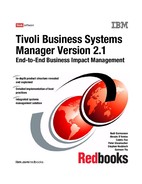50 Tivoli Business Systems Manager Version 2.1: End-to-End Business Impact Management
component, but a monitoring profile cannot be associated with more than one
software component.
Distributed Monitoring profiles also can be added to APM-defined software
components. For example, to associate a monitoring profile for Domino™
monitors to the APM-defined instrumentation of Tivoli Manager for Domino, we
use the gemdmmap command to create an association for a monitoring profile to
the APM-based Domino object class. The sentry events that are sent by the
profile are processed as APM Threshold exceptions. The software component
instance must be created with the APMHeartbeat event. Distributed Monitoring
events will correlate to APM instances when the monitoring profiles are
distributed to the same managed node or endpoint where the APM resources are
located.
The Distributed Monitoring events must be forwarded to IBM Tivoli Business
Systems Manager using the ihstztec exit.
Generic TEC interface
The generic TEC interface provides the ability to integrate a generic TEC event
into IBM Tivoli Business Systems Manager objects as a generic GEM object
class. The events that are not triggered by Tivoli Distributed Monitoring can also
be forwarded to IBM Tivoli Business Systems Manager and defined as a
separate software component using this API.
Use gemgenprod.sh to define a generic distributed object. TEC event forwarding
should be performed using the ihstttec exit. Most of the objects defined and
created for the IBM Tivoli Monitoring for products are defined in this class.
Mainframe objects
This class represents APM objects that are instrumented using IBM Tivoli
NetView for z/OS Application Management Instrumentation (AMI). The objects in
this class are created under the Operating System object, under the Complex -
Machine - LPAR hierarchy based on the content of the host name field.
AMI resources receive the APM Heartbeat and APM Threshold events similar to
other APM resources. The only difference is that the event is sent from Tivoli
NetView for z/OS through the Event Automation Services to TEC. There is no
interface to create this type of object.
Refer to
Instrumenting Enterprise Application using Tivoli GEM
, SG24-5399 for a
complete discussion of AMI. There is no creation interface for these mainframe
objects. However, a sample creation script gemmfprod.sh is provided in “The
gemmfprod.sh script” on page 558.

Chapter 2. Components and functions 51
2.3.2 Common listener
The common listener interface provides a generic interface in which any type of
object can be created, updated, or deleted. Figure 2-9 shows the detailed
mechanism of the common listener.
Figure 2-9 Common listener connection
IBM Tivoli Business Systems Manager has an adapter that collects event data
from distributed data sources as follows:
? IBM Tivoli Monitoring
? IBM Tivoli NetView
? Tivoli Workload Scheduler V8
? BMC PATROL
? Unicenter TNG
? NetIQ
The Common Listener service enables products to send bulk discovery, delta
discovery, and event information to IBM Tivoli Business Systems Manager
without going through TEC. Depending on the sending adapter, resource
discovery information can be sent through the common listener service with the
events routed through TEC for correlation.
The common listener transport uses message queueing technology that is
implemented in Java. It transports extended markup language (XML) messages
that are formated using the Simple Object Access Protocol (SOAP). Three types
of objects can be manipulated using the common listener interface:
? Instance, which relates to a real resource instance in the IBM Tivoli Business
Systems Manager database. This type of object can be created, updated, or
deleted.
? Link, which relates to a physical containment link or topology link in IBM Tivoli
Business Systems Manager. A link can be created or deleted only.
? Event, which can be applied to an instance.
TBSM Database
Common listenerApplication TBSM adapter transport layer

52 Tivoli Business Systems Manager Version 2.1: End-to-End Business Impact Management
Example 2-4 shows a sample event formatted in XML.
Example 2-4 Formatted XML for an event through Common Listener
<event>
<time>1037738248</time>
<id>
<class>OperatingSystem</class>
<instid>os_ibmtiv9</instid>
</id>
<type>TMW_HighProcesses@TMW_Processor</type>
<context>[666252843]Processor=0;</context>
<tbsm>
<type>EXCP</type>
<desc>High CPU Usage,
High CPU Usage User Priv,
and High CPU Usage Process
are exceeded on the processor 0.
(;highprocesses= 2.0000
;idprocess= 204.0000
;percentprocessortime= 98.0000
;process="CSRSS"
;processor="0")
</desc>
</tbsm>
<tecstatus>
<severity>CRITICAL</severity>
</tecstatus>
</event>
More information about the database structure of common listener can be found
in 3.6, “Common listener resources” on page 95.
..................Content has been hidden....................
You can't read the all page of ebook, please click here login for view all page.
